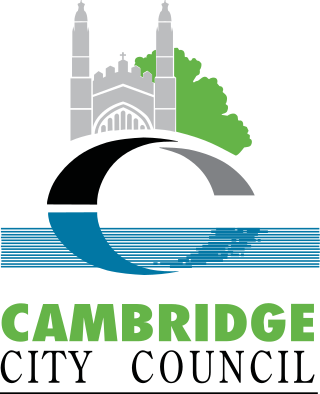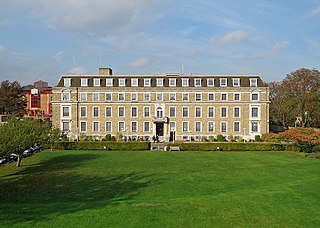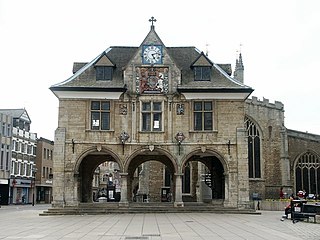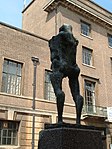
In local government, a city hall, town hall, civic centre, guildhall, or municipal building is the chief administrative building of a city, town, or other municipality. It usually houses the city or town council, its associated departments, and their employees. It also usually functions as the base of the mayor of a city, town, borough, county or shire, and of the executive arm of the municipality.

Cambridge Castle, locally also known as Castle Mound, is located in Cambridge, Cambridgeshire, England. Originally built after the Norman conquest to control the strategically important route to the north of England, it played a role in the conflicts of the Anarchy, the First and Second Barons' Wars. Hugely expanded by Edward I, the castle then fell rapidly into disuse in the late medieval era, its stonework recycled for building purposes in the surrounding colleges. Cambridge Castle was refortified during the English Civil War but once again fell into disuse, used primarily as the county gaol. The castle gaol was finally demolished in 1842, with a new prison built in the castle bailey. This prison was demolished in 1932, replaced with the modern Shire Hall, and only the castle motte and limited earthworks still stand. The site is open to the public daily and offers views over the historic buildings of the city.

A guildhall, also known as a "guild hall" or "guild house," is a historical building originally used for tax collecting by municipalities or merchants in Europe, with many surviving today in Great Britain and the Low Countries. These buildings commonly become town halls and in some cases museums while retaining their original names.
A county hall or shire hall is a common name given to a building that houses the seat of local government for a county.
Charles Cowles-Voysey was an English architect.

Cambridge City Council is the local authority for the city of Cambridge, a non-metropolitan district with city status in Cambridgeshire, England.

Cambridgeshire County Council is the county council of Cambridgeshire, England. The council consists of 61 councillors, representing 59 electoral divisions. The council is based at New Shire Hall in Alconbury Weald, near Huntingdon. It is part of the East of England Local Government Association and a constituent member of the Cambridgeshire and Peterborough Combined Authority.
John Brandon-Jones was a British architect. His work was heavily influenced by the Arts and Crafts movement, of which he was a noted architectural historian.

Guildhall Street is a street in central Cambridge, England. To the north is the southeast corner of Market Hill at the junction with the pedestrianised shopping street Petty Cury. To the south it continues as Guildhall Place, a cul-de-sac, at the junction with Wheeler Street, close to the northern end of Corn Exchange Street.

Norwich Market is an outdoor market consisting of around 200 stalls in central Norwich, England. Founded in the latter part of the 11th century to supply Norman merchants and settlers moving to the area following the Norman conquest of England, it replaced an earlier market a short distance away. It has been in operation on the present site for over 900 years.

The Shire Hall is a municipal building in Fore Street, Hertford, the county town of Hertfordshire, England. The building, which currently serves as a Magistrates' Court, is a Grade I listed building.

Watford Town Hall is a municipal building in Rickmansworth Road, Watford, England. It is a Grade II listed building.

Shire Hall is a former municipal building in Castle Hill in Cambridge, Cambridgeshire, England. It was the headquarters of Cambridgeshire County Council from 1932 until 2021, when the council moved to New Shire Hall at Alconbury Weald, some 23 miles from Cambridge.

County Hall is a former municipal building, now used for student accommodation, in Hobson Street, Cambridge, Cambridgeshire, England. It is a Grade II listed building.

The Old Shirehall was a municipal facility in Market Square, Shrewsbury, Shropshire. It was demolished in 1971 to make way for a retail and commercial centre.

The Guildhall is a municipal building in Cathedral Square, Peterborough, Cambridgeshire, England. It is a Grade II* listed building.

Peterborough Town Hall is a municipal building in Bridge Street, Peterborough, Cambridgeshire, England. It is a locally listed building.

Friern Barnet Town Hall is a municipal building in Friern Barnet Lane in Friern Barnet, London, England. The building, which was the headquarters of Friern Barnet Urban District Council from 1941 to 1965, is a Grade II listed building.

Worthing Town Hall, or New Town Hall, is a municipal building in Chapel Road, Worthing, West Sussex, England. The town hall, which is a meeting place of Worthing Borough Council, is a Grade II listed building. Located at Chapel Road in the centre of Worthing, it was opened in 1933 and built in a neo-Georgian style to designs by Charles Cowles-Voysey. Containing offices and a Council chamber it replaced Worthing's Old Town Hall as the administrative centre, a building that had been the home of Worthing's local authority from 1835 and was demolished in 1966. To the rear and west lies the Assembly Hall, built in 1935, also to designs by Cowles-Voysey. To the south lies the Worthing Museum and Art Gallery, originally built as a Carnegie Library.

The Municipal Offices are located on Queen Victoria Road in High Wycombe, Buckinghamshire, England. The structure is used as the High Wycombe local area office of Buckinghamshire Council.






















